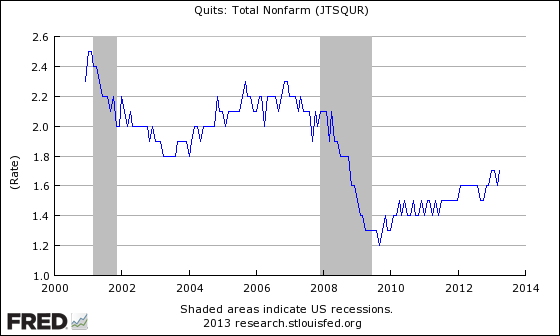
The job market recovery continues on in steady but unspectacular fashion, with employers adding fewer than 200,000 workers for three straight months through May. Given the pace of job growth over the last 12 months, it will take more than six years for the unemployment rate to return to prerecession levels. Here’s one slightly encouraging sign about the state of the labor market, though: more people are quitting their jobs.
The Labor Department reported Tuesday that the number of people quitting increased 7.2 percent in April to 2.25 million, even as the number of job openings fell 3.4 percent to 3.76 million, the fewest since January. The ‘quits rate’ – the number of people quitting as a percent of total employment – was little changed, moving from 1.6 percent in March to 1.7 percent in April, according to the Job Openings and Labor Turnover (JOLTS) report. That’s not much higher than the low of 1.2 percent reached in the wake of the Great Recession, but it still represents the highest rate we’ve seen since the downturn.

There’s a long way to go before the churn in the labor market looks normal. “The most striking aspect of the JOLTS data continues to be the low level of both hires and separations: Turnover in the labor market remains down sharply relative to before the crisis,” wrote Jim O’Sullivan, chief U.S. economist at High Frequency Economics in a note to clients before Tuesday’s data release. Voluntary quits are still 22 percent below their 2007 level, according to Heidi Shierholz at the Economic Policy Institute.
Workers voluntarily quitting their jobs is seen as a sign of labor-market strength and an indicator of broader economic improvement. “While the quit rate may sound a little quirky, it actually holds the key to a more buoyant and durable recovery,” Wells Fargo economists wrote last month. “When the labor markets strengthen to the point where a larger proportion of workers are willing to voluntarily leave a job, then a larger proportion of workers would also be willing to start a family, buy a home and start a business, all of which are lagging badly in this recovery.”
A lack of quitters likely reflects what are still relatively weak levels of hiring – and the scarred psyches of workers stung by the financial crisis. The number of monthly hires, at 4.43 million in April, is still almost 15 percent below the level seen in 2007, when new hires averaged 5.19 million a month. “To some extent, the drop in the quit rate may be due to the aging of the population, with younger people more likely to job hop,” O’Sullivan wrote. “However, much of it likely reflects lingering risk aversion after a severe financial crisis and recession; fewer people are willing to take a chance and quit without a job lined up, or even to start over at a new firm when there are new opportunities. From that perspective, a rising quit rate would be a good sign for the normalization of the labor market.”





